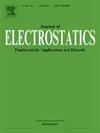颗粒物质静电分离的最新进展
IF 1.9
4区 工程技术
Q3 ENGINEERING, ELECTRICAL & ELECTRONIC
引用次数: 0
摘要
自上世纪中叶以来,静电选别已成为选矿的一项标准技术。在过去的40年里,它越来越广泛地应用于从工业废料中回收有价值的材料(金属、塑料)。本文旨在回顾作者最近开发的几种解决方案,以克服几个主要的技术挑战:(i)在产品的小时吞吐量,回收率和纯度方面,推动现有静电分离在回收工业中的应用的极限;(ii)加工更复杂的颗粒状或粉状混合物,包括溴化塑料和片状材料;(iii)从碎废物中回收纺织纤维。本文简要介绍:(1)一种新获得专利的模块化多功能静电分离器;(ii)对含溴化阻燃剂的塑料三元混合物进行摩擦静电分离的原始程序;(iii)用于从包装废料中摩擦静电分离聚乙烯和聚苯乙烯薄片的改良工业装置;(iv)一种正在申请专利的设备,用于从报废轮胎中回收PET纤维。至少在下列领域应继续研究扩大静电分离的应用:(i)复合材料的回收;(二)食品、医药行业细粉的回收;(三)从微细化的废旧电器和电子设备中提取高价值金属。本文章由计算机程序翻译,如有差异,请以英文原文为准。
Recent advances in the electrostatic separation of particulate matter
Since the middle of the last century, the electrostatic separation imposed itself as a standard technology in mineral beneficiation. During the last 40 years, it has been more and more widely applied for the recycling of valuable materials (metals, plastics) from industrial wastes. The present paper was aimed to review several recent solutions developed by the authors to surpass several major technical challenges: (i) push the limits of the existing electrostatic separation applications in the recycling industry, in terms of hourly throughput, recovery and purity of the products; (ii) process more complex granular or powdery mixtures, including brominated plastics, and flake-like materials; (iii) recover textile fibers from shredded waste. Described in this short review are: (i) a newly patented modular multi-functional electrostatic separator; (ii) an original procedure for the tribo-electrostatic separation of ternary mixtures of plastics containing brominated flame retardants; (iii) a modified industrial installation for the tribo-electrostatic separation of polyethylene and polystyrene flakes from packaging waste; (iv) a patent-pending equipment for the recovery of PET fibers from end-of-life tires. Research should continue to expand the application of the electrostatic separation in at least the following areas: (i) recycling of composite materials; (ii) recovery of fine powders in food and pharmaceutical industry; (iii) extracting high-value metals from micronized waste electric and electronic equipment.
求助全文
通过发布文献求助,成功后即可免费获取论文全文。
去求助
来源期刊

Journal of Electrostatics
工程技术-工程:电子与电气
CiteScore
4.00
自引率
11.10%
发文量
81
审稿时长
49 days
期刊介绍:
The Journal of Electrostatics is the leading forum for publishing research findings that advance knowledge in the field of electrostatics. We invite submissions in the following areas:
Electrostatic charge separation processes.
Electrostatic manipulation of particles, droplets, and biological cells.
Electrostatically driven or controlled fluid flow.
Electrostatics in the gas phase.
 求助内容:
求助内容: 应助结果提醒方式:
应助结果提醒方式:


